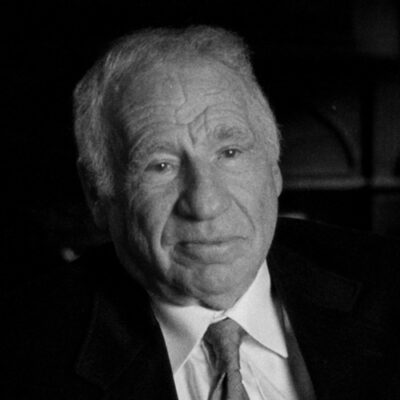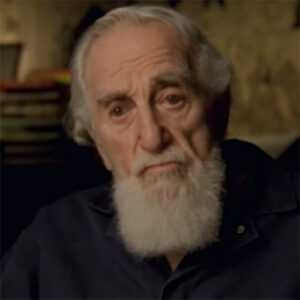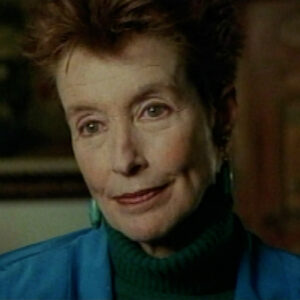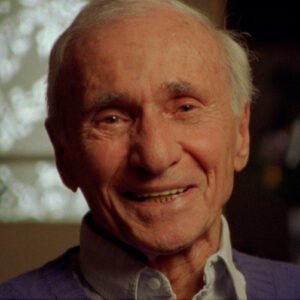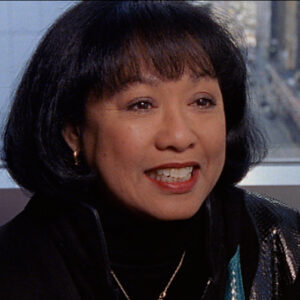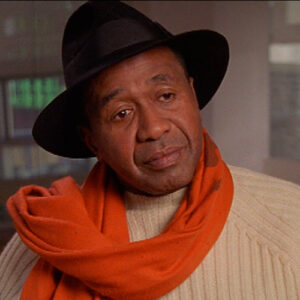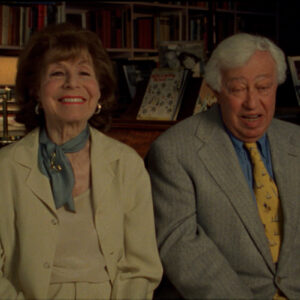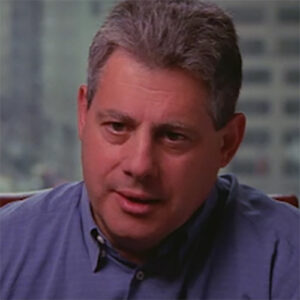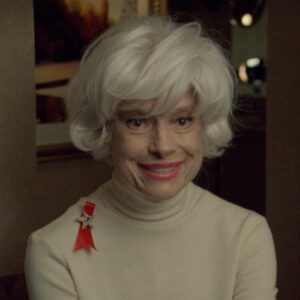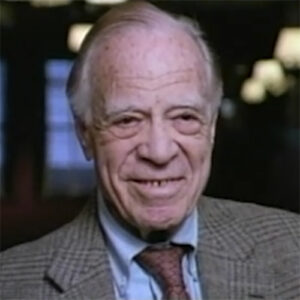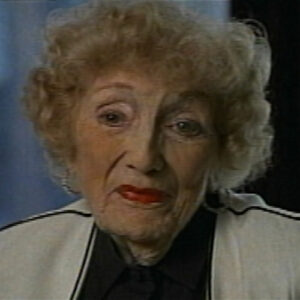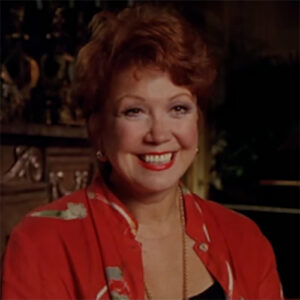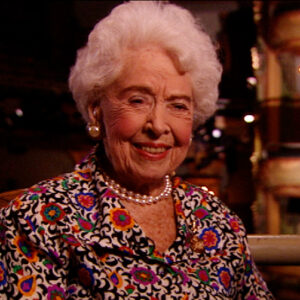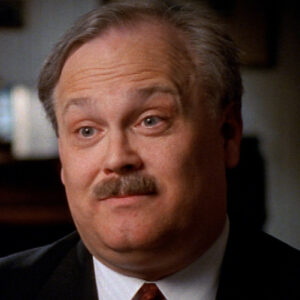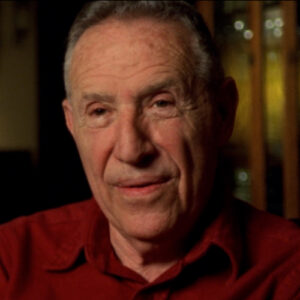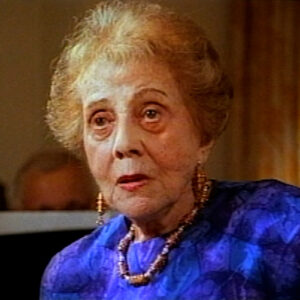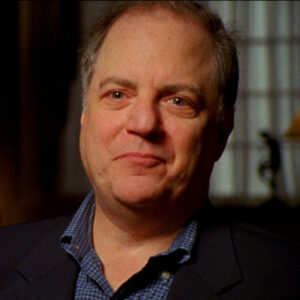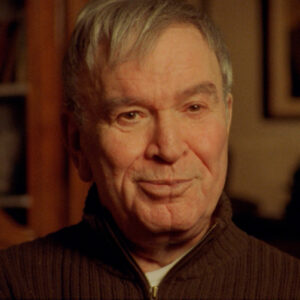Michael Kantor: So thinking back to On the Town, Bernstein’s first Broadway thing, Betty Comden said, an unusual thing which makes it unique even today is Lenny scores a symphonic score. And nobody, she said, nobody could do it but Lenny. So tell us, you know, at that point in his life, he’s just taken over from the ailing, Bruno Walter, whatever, he is, what does he bring to the musical that very few other people have or that’s unique to Lenny with On the town?
Michael Tilson Thomas: Well, Bernstein saw what a lot of people before him had seen that within the shoving and hauling and silly progression of storyline in a musical, that there was an opportunity for the music itself to take the audience to a much more inspired and visionary place. There were precedents for this. The Gershwin musicals, by and large, had rather silly, frothy plots, but the songs had a poignancy and musical depth of expression. The dance choruses, the little items that were brought into the score to transform those pieces into considerably more profound experiences and ultimately the experiences that would haunt you forever. Bernstein had these things in mind as well as the model of Rogers and others and thought he could expand upon this in his own way using this fusion of musical languages he is developing. Which came, of course, from Gershwin, from Copland, from all sorts of pop music he had transcribed.
Michael Kantor: Help us understand, I mean, I guess with the exception of Gershwin, was there, I mean, is it unusual for a guy who’s conducting a big orchestra across town to then hop into the Broadway world? Was that more common then? I mean does that happen now? Speak to just, was Lenny an anomaly with that regard or at that point, I don’t know, I gues Gershun’s probably the best.
Michael Tilson Thomas: Lenny was a very visible example of what one would have to call showbiz intelligentsia. And there are a lot of us out there. Certainly Steve Sondheim is an absolute paragon of that category living now. But many people within the world of music, within the word of show business had those minds very aware of literature, very aware of wisecracks, very aware of the… Deliciously delightful and sometimes embarrassing history of our art and reveling in all sides of it. So it was perfectly natural for him to see the folk dance village musician absurdities that are embedded in Mahler symphonies as well as himself being able to evoke the kind of goofball antics appropriate to a sequence in Coney Island, for example.
Michael Kantor: When Betty says it’s a symphonic score, I mean, Lenny has the same number of people as someone else writing, who’s writing your basic Broadway musical score, what does she mean by he had a sym-phonic sound?
Michael Tilson Thomas: Different musical sound different ways according to how prominently various instruments within the orchestra may be used. Of course this lush symphonic aspect of a musical score had come forward strongly in Richard Rodgers musicals. Think of all those wonderful ballet sequences in many of his shows and in the general sound of a show like South Pacific, you know, the wonderful. Doubling the voices and the descants. Who can forget the English horn part to Bali Hai? It’s even better than the actual tune. Example was something that Bernstein took on and followed and perhaps developed further in imagining that the orchestra itself could be a major protagonist in the musical and the dance sequences could have a kind of drive, a kind danger that was very powerful. Gershwin in a show like Porgy and Bess which had much higher operatic ambitions had done things like this. But there were other shows that did that. Some of the dance, there were others shows that did that, some of the dancing sequences in Brigadoon, for example, the chase sequences had a kind of desperation and ultimate tragic consequences since the pattern of writing a serious musical for a lot of people was basically you kill off the second boy and there were various ways of doing that. Leaving the. The first girl the first boy happily alive but you know somebody has to die just to make it uh… Have that tear-jerking punch
Michael Kantor: Um
Michael Tilson Thomas: That’s true, isn’t it, Mike? When in doubt, kill off the second boy.
Michael Kantor: The precedent for it on the town is a ballet. Let’s take it from there. What led Bernstein to his first Broadway show?
Michael Tilson Thomas: My take on the evolution of Bernstein as a Broadway writer is that it came a lot through little entertainments that he had devised in the earliest part of his life, little skits at Harvard and little pieces put together just to be a novelty number and a review that he had done with Betty and Adolph. And it’s the way material for a show sometimes… Evolves. It kind of accumulates. You’ve got this number and this number, and this number, then suddenly begins to have a certain flavor. Somebody else comes into the mix. Jerry Robbins, a certain approach to dance. A lot of nights out and about New York, visiting different kinds of clubs, and in the case of West Side Story, observing a lot the way kids actually danced in parties, gymnasiums, wherever they were going. Beginning to see how it could be abstracted and focused to have a clear narrative line. Just sort of happens. And in the case of West Side, the amazing group of people who were working on that between Arthur and Steve and Jerry and Lenny, it’s just very creative people with very wide-opened eyes and ears and amazing abilities to kind of connect the dots. So it all suddenly seems coherent.
Michael Kantor: Getting back to that second part of the question, Lenny in New York City, everyone remarks upon, and I guess like Gershwin of his era, that something in Lenny’s music is inherently New York. And obviously he doesn’t grow up in New york city, but what is it about his music that you’d say says New York city?
Michael Tilson Thomas: Bernstein was able to capture a kind of hyper-energized throb of the city. He was able deal with the mordant, whiny quality of the voices in its streets and many of the musical traditions that existed within it. It’s something he had thought about quite a bit when he was living in Boston and going to Harvard. Made regular trips to New York. And one of the earliest pieces he notated in a notebook was something called something, I think it was like Notes from the City of Sin. And that little bit of thematic material actually went into On the Town. It’s one of tunes that’s the opening of the imaginary Coney Island sequence. So there was somehow this kind of aching knock. Eternal sound he clued into, again, very, very much coming from his admiration of Gershwin, the second piano prelude side of Gurshwin and also the kind of driven city music side of Gorshwin in American and Paris, or indeed in the music for the second Rhapsody, which from a film I think called Delicious, which had a very big. Sequence city sequence. This is the city kind of sequence
Michael Kantor: America, the West Side Story. How is Bernstein’s love and belief in American music get expressed in that song and in the score of West Side Story?
Michael Tilson Thomas: Which song? America. Haha. Well. You know. A great deal of West Side Story reflects the preoccupations of a whole generation of composers, like William Schumann and Leonard Bernstein, and before them Aaron Copland, with many different musical genres of recognizing that in the United States that we had blues, that we had music hall, that we had Jewish music, that had time. Hispanic music that we had so many different categories of music within each one of these kinds of music. Realizing there was a lot of possibility about combining many different grooves into one show or even sometimes. West Side Story, from its musical content point of view, worked very well because you have two rival families, gangs, who have different musical styles. You’ve got the Jets who have that street-wise New York kind of, yeah, yeah says you kind of jazz-inspired music, bebop-inspire music, and then you’ve got the Sharks with the whole world of Latino music inside of it. These musical elements, of course, have been present in other American composers’ work. Copland was the one who really brought in all these pieces, Danzan Cubano, El Salon Mexico, the abrupt shifts of rhythm. Even his third symphony had been a kind of pay-on to Pan American triumph with all of its wonderful sweeping themes of the broad prairies, but also with a fugue that was absolutely out of Cuban dance hall music. So. Pattern was there, that idea was there but characterizing it dramatically and letting it play out on stage and allowing it to fuse and overlap in these dramatic situations was inspired.
Michael Kantor: Okay, what about, I mean, is there Mauer, Stravinsky, and what, for, I mean, he’s drawing, Bernstein’s drawing on Koblen, clearly. What are, who else is he drawing on?
Michael Tilson Thomas: Oh well, sure.
Michael Kantor: For West Side News.
Michael Tilson Thomas: There are lots of other influences in West Side Story, of course. Stravinsky, big time, Mahler in certain places. Well, even the end of West Side story is the same ending as Strauss’s also Sprach Zarathustra of all things. But that was Lenny’s genius that he was able to blend all of these musical strands in such a way that they became utterly original and you enjoyed following his. Fertile mind through its virtuosic capers in multiple stylistic adventures. I can’t believe I said that. He would have liked that.
Michael Kantor: No, there’s the down and dirty apparently, you know, some cheap cafe somewhere inspired of something. It’s not just high art, was it?
Michael Tilson Thomas: Lenny appreciated art wherever it came from. It was high brow or low brow, it was equally important to him and he saw them as happily, even necessarily coexisting. One of Lenny’s great pieces of advice to a young composer was remember, everybody steals, but when you steal, steal classy. And he was brilliant at that in disguising very often where some of these things were coming from, putting his own stamp on it, absolutely, and connecting it into the tradition of things. Sometimes he surprised himself. He didn’t realize where it was actually coming from. It was so original, but it did, of course, have some basis, some foundation in the rest of the world, as good music always does. And one piece we were working on one time, premiering a piece, and we were playing it, and I suddenly turned to him and said, Lenny, you know what this is? This absolutely is. Pictures in an exhibition, Mzorkski’s picture in an exhibition, and he kind of stopped for a second and he looked at me and said, Mczorkski? Picture in an Exhibition? Never heard of it. It’s fun for friends of Lenny, for musicians, to follow how many different streams of music he was able to bring into his own work, but don’t be deluded. He is an utterly original person. He has something very particular to say, and there is an instantly identifiable quality to anything that he wrote, and that’s why we all cherish it so much.
Michael Kantor: Where do you think he placed Broadway in the realm of?
Michael Tilson Thomas: Bernstein I know adored Broadway, its history, and the wonderful messages that it conveys, conveyed. He was concerned about it. He felt it had become much too cumbersome, much too expensive, much too difficult, much too daunting to try and take something as fragile as a dream or a wisecrack and spin it into a whole evening. He resented the number of people involved who were not creative people, who were looking over the shoulders of the writers and composers, and at every step of the way, trying to poll or second guess what the direction of the show would be, what its commercial possibilities would be. He didn’t like that, and he knew that that. Was a very, very dangerous trend for. Broadway theater continuing in an original direction. It threatened the originality of the future of the idiom.
Michael Kantor: Would you say in today’s corporate world, with the corporations taking over Broadway, he would have been very uncomfortable? Why don’t you place it? Can you imagine Leonard Bernstein doing a musical for Broadway right now, with Disney, with all those kind of influences, or a bunch of friends putting on a show for him?
Michael Tilson Thomas: Broadway had certainly been for him a bunch of friends putting on a show and being as personal as possible. He was a real trooper about rolling up his sleeves and tackling any project, no matter how daunting and no matter how many suits were snooping on the sidelines, but it was growing more difficult and I think part of his spirit was going the direction, Well, if it’s going to be this. Big, this difficult, this serious, all this investment in this, perhaps it would be better to look at another form, symphonic music or operatic music or something where, okay, from the beginning it’s assumed to be, quote, serious, unquote.
Michael Kantor: How do you characterize Stephen Sondheim? Isn’t, aren’t shows like Sweeney Todd and other things he’s done pushing the envelope like other great guys did in the past. How do your characterize his music within again? Is it, where does it, where does rest within that big musical spectrum of hip hop and blues and classical music? How do place them?
Michael Tilson Thomas: Steve’s music always pushes the envelope because it explores the attractive power of great words and great grooves. A lot of his songs are about a wonderfully spiky, slightly off-kilter rhythm track during which the words come in and out in unexpected places and the kind tension between the contour of the vocal line and the sheer sound, the kind of patter sound of the fronts and ends of the words and the lovely spiky sounds of the rhythm track make a very excited, particular feel unique to him. In this way I see a lot of his music related to Stravinsky and I see it related to some the minimalist composers, but his understanding that you can occupy a large space of time with something that has a particular rhythmic flavor in which then there’s also a melodic and wonderful word information has been something that has been completely unique and wonderfully satisfying.
Michael Kantor: Where does Sweeney start?
Michael Tilson Thomas: Let me say this one more thing, you know, there’s a lot of structure in Steve’s pieces. As a classical musician, I’m always amazed. Time units work out and how sometimes wonderful confluences of material that’s been introduced in one point of the show or the other, you know, really fuses, comes together. I don’t know that the public is necessarily so aware of those things or those who write about the theater are so aware, but as a classical musician I hear these things and I was delightedly impressed with them and delighted by them.
Michael Kantor: With Sunday in the Park, which people, Frank Rich calls a watershed for Broadway, it makes me think of that minimalist, you mentioned minimalist before, and how is, I mean, he’s not working with Harold Prince here, he’s working with James Lapine. How is Sunday interesting to you musically, and the piece we’re looking at is like, you know, color and light, there’s a sort of pointillistic, he manages, which we all try and do in all of our work. To take form and to take content and use it as a way to generate form, which is a, what’s your take on that?
Michael Tilson Thomas: Sunday in the Park is very powerful formally and the songs, the opening song, the title song or finishing the hat are two perfect examples of the way the tension of the rhythmical situations and the simple little almost folk song like melodic contours and the very witty words expressing such different shades of inspiration, annoyance, boredom, whatever they are, continuously transform your way of perceiving this time. I think it’s great stuff. Porgy and Bess is a tremendous, deeply touching masterpiece. It’s the piece in which Gershwin’s powers at their absolute maturity are completely unleashed. He has such a broad canvas to be able to show us just how many moods, how many feelings, how many observations of the way life is. He sees and can make us feel and understand through his soul. I think particularly its power is that as the character Porgy at the end of the show goes off searching for something into an unknown future and you have the sense of his probable doom that you also hear this piece and have that sense of Gershwin at that point being on the brink of an unknown future, which would have had. Colossal consequences for the whole future of American music and also we know that sadly he did not go on to achieve this so somehow the story of the opera and the story his life have become one mythology which no American can ever forget.
Michael Kantor: What about… This was his first venture to opera, per se, right? I mean, he started just very quickly, if you would. Trace, he’s self-taught in a way. He moves through the earliest tin pan alley and how this is kind of the culmination of those different steps from concert hall and political musical and so on.
Michael Tilson Thomas: I’m not quite sure what you’re asking.
Michael Kantor: I guess I would, if you can take where he starts and where he ends as a way to, like he starts off song plugging and it’s amazing within a period of however many, 20 years, he in a certain sense represents an American voice going from, you know, these kind of Tin Pan Alley simple tunes to what we now think of.
Michael Tilson Thomas: Much has been made of Gershwin’s, quote, humble origins, unquote, as a song plugger and all the other, you know, workaday things he did. But I think he was very much in possession of his own voice right from the very beginning. Very early songs like How Long Has This Been Going On, and then through songs in the middle of the Broadway period like The Man I Love and whatnot, have that same big, lyrical, achy, haunted quality that we hear in Porgy and Bess. It’s just that he was writing for a theatrical form which required many different kinds of music, a lot of them novelty songs and frothy songs and patter songs and all kinds of other songs. So when the opportunity was there, that was part of his soul. He had no problem in witnessing to it, just that was yearning for a larger dramatic space in which he could completely open up that part of himself.
Michael Kantor: What about, you know, he writes about wanting to, my time is now, I’m an American. Clearly, he wanted, speak to his wanting to break with whatever influences were there and embrace the sort of new American voice that overtook our culture.
Michael Tilson Thomas: Well, I see the urgency of his desire for self-expression and bravely going into these new kinds of musical languages as part of a larger yearning of the Yiddish-Kite movement in the United States because he is one of many composers and writers who had come from backgrounds of living in these little shtetls in Eastern Europe where. For generations the creativity of these folks had been bottled up either only into cantorial music, liturgical music, or perhaps into being entertainers at parties. But, you know, very limited horizons of what they could do. Suddenly they get to the United States and all of this spirit that has been so long constrained is in a society in which anything is possible, any dream can be achieved. And this is this explosion that you see in… Gershwin, and Berlin, and Copeland, and Bernstein, which it’s all one expression. Of the I Sing is such a delightful show because it presents the totally absurd situation of a political candidate running on the platform of love. Sadly, we’ve come to know that such a platform is not at all absurd. It just is part of the general hucksterism of the selling of these so-called candidates that we observe in. The show was great because of the outrageous characters, Throttled Bottom, Wintergreen, all these folks who are such representations of smarmy, goody-two-shoes-ness and, you know, toadiness and all these things. And his wonderful ability to understand the nature really of Broadway character actors. And performers. And he and Ira both knew these people so well, the kind of schtick they could do and the kinds of outrageous parody that they would be able to deliver and just gave them perfect material to be able to inhabit those characters. That’s why the show worked so well. It also was a show in which there was a very big role for the chorus and soloists within the chorus, representing this variously, the Supreme Court or you know, whoever they are. There was a kind of wacky Marx Brothers-like quality to the scenarios of those situations, the crazy entrances and exits and appearances, disappearances. And then, of course, there were some totally great haunting numbers, so it just works. Still works. Of the I Singin’, many of the Gershwin musicals has a kind of Gilbert and Sullivan quality. You know, someone sings a line, their chorus repeats it, or they repeat it with one word. Altered, you know, these little jokes, get him, get her, get them, you know, going back and forth, which had been a big part of GNS. But as I say, he really appreciated so much, George and I were both appreciated so much. The people for whom they were writing. So, they knew they had someone like… Merman and that a song like I got rhythm another show of course But nonetheless that that kind of belter would be there to deliver that number or they had Clark a McCullough Who could do a number like, you know, I left my mademoiselle the new Rochelle, but what the hell you’ll do as well You know, they they could grasp the people they really had to work with The zaniness of the situation and create something that was so idiomatic You could scarcely believe that it wasn’t just improvised on the spot That was a lovely quality. You didn’t feel the wheels turning, laboriously creating the situation. It was all like, oh, sure, nothing to it.
Michael Kantor: Where did the Broadway musical come from?
Michael Tilson Thomas: There is a huge connection between Broadway and the American Yiddish theater. I didn’t realize how powerful a connection it was until I first began coming to New York as a kid. Boris and Bessie Tomaszewski’s grandson, and living on the West Coast, I just knew that my grandparents had something to do with the Yiddish theater. But when I came East when I was around 11 years old, I wanted to go to see a matinee of Fair Lady, which was the hottest ticket in the universe at that particular point. And I was told to go up to the stage door and ask for the company manager and introduce myself, and I just knocked at that stage door and. Said, hello, I’m Boris Tomaszewski’s grandson. And two seconds later, I was in the absolute best house seat right in the fifth row center with thousands of people lined up outdoors desperately trying to get a seat. I had no conception until then of what my grandparents’ work and that theater, Jewish theater, had meant to the world of Broadway. Because running the Broadway houses… If not in view of the public, certainly behind the scenes, was the whole hierarchy of people, many of whom had grown up in and around the Yiddish theater. There are other examples of this. The famous Cradle Will Rock event was reported by Wells and Hausman a particular way, but having grown up with a lot of people who were actually there on that production, I heard a very different story. I heard the story about… Welles and Hausmann actually running for cover as fast as they could, wherever they could run, to avoid their careers being damaged by the government censure. And quite to the contrary, radical youngsters who were on that show, who belonged to the electrician’s union, the carpenter’s union. The various, you know, unions, all of which had come out of the Jewish theatrical unit. All of which had come out of the Yiddish theatrical. Unions since the Hebrew Actors Union was the first performing arts union in the United States and in various ways the charters of all succeeding performing arts unions come from it. This is what really motivated that spirit of radicalism and of challenge and excitement which Broadway for so long did represent. There are many, many, other connections to this. You can actually hear it in the music. So, for example, Bessie Tomaszewski, my grandmother’s song, one of her signature songs was from a show called Hansi and America. And this was by Romszynski, and it had two distinct parts. One, which was a kind of Yiddish sounding part, and another part which sounded, well, this is about 1910 or so. And the two parts, one part… And so on. So you can hear this whole jazzy, swingy, American Broadway thing coming into focus in a lot of those shows. How much were the great American musical composers aware of this? They were certainly aware of it. Irving Berlin was all over my grandparents and other Jewish theaters and cabaret performers as a lad. The Gershwins were very, very much aware of his music. We know that George was. Hunter one summer where my grandparents had a house when he was a youngster and a pal of my Uncle Harry and he heard ramshinsky working on a couple of shows. That’s a broken a fiddler and I think partially some of Hansi whatever They could play this music and they played it for fun Not only they could play it when I came to New York I discovered that Leonard Bernstein and Adolf Green and all kinds of other people in the showbiz world knew this music very well They knew the old routines. They had a million one-liners that all related to Yiddish. In fact, the underlying joke that repeated endlessly in various variations was to have a Yidddish word, a Yiddish expression be brought into a conference, a script conference, a music conference, you know, an old line of Fanny Brice’s or of Sophie Tucker’s or of my grandparents or whoever was there all the time. That’s been lost. People don’t get that anymore about how powerful Yiddishkeit was in the foundation of Broadway, and that the direction of Yiddischkeit was twofold. It was to amuse, but it was also to instruct, and that theater could be used ultimately as a medium for showing people on stage how certain situations in life might play out, and hopefully offering them the opportunity to learn. From the examples that they saw on stage. So this is a very, very powerful tradition. Recently, Jack Gottlieb, after 40 years of work has completed a manuscript called Funny, Doesn’t Sound Jewish, which is an amazingly exhaustive source of how these parallels between Jewish liturgical music and cabaret music and theater music were troped, copied in many cases, modeled to be used in the early days Broadway theater and it is a delightful and amazing exercise to see how that proceeded.
Michael Kantor: Gershwin’s around the time of Lady Be Good, Fascinating Rhythm. How is the 32 bar sort of tin pan alley standard being exploded and wonderfully played with? And what do both George and Ira do to take something that’s kind of a commercial thing and just elevate it a notch to something that we all like to enjoy today?
Michael Tilson Thomas: I think both the Gershwin brothers had a wonderful witty sense. Rhythm in words, rhythm in music. And it’s always that catchy little inner tricky rhythm to the melody, to the rhyme scheme that makes those tunes have the ingenuousness and catchiness that they really have for all of us. And they were a great pair. They just shared that in common. Very often in listening to an early Broadway song, you can think that you’re hearing a Jewish song. So there’s not all that much difference between a song like Grina Kuzina. And the opening of Swani. And so on, it’s that same kind of musical chunky doggerel. So here’s a famous old song, Grina Kuzina, a Yiddish hit. And here’s the opening of Gershwin’s Swani. They come out of the same world. Gershwin took this all much further on a unique direction and exploration of his own, but do they have common roots? Sure.
Michael Kantor: Why such a strong Jewish influence on the Broadway musical?
Michael Tilson Thomas: The Broadway musical was the first American idiom where the stuff of dreams could really be realized. Before the movies really took off, you could create a magical world on stage. You could say irreverent things in a charming way that people would accept that would be quite controversial or maybe even actionable if they appeared in the press. So it appealed to the love of the mordant comment, the wisecrack, the soulful confession, the oi, oi oi ache of so much of Jewish life. All these things could be woven into a show. And after hundreds of years, thousands of years of the creativity of Jewish people being so suppressed. Particularly those who became the songwriters in America. They were the ones who came from the Eastern European origins, Russia, Lithuania, this part of the world, where in these little shtetls, which were really villages, they had that contact with the raw energy of life, the cycle of the seasons, the sexual energy of what it means to be around animals, the earth, you know, all this stuff. And what could they do with all that energy? It just had to go into songs for the synagogue or. Entertainers like Badchens standing up in a chair and telling a story, or a klezmer musician going from wedding to wedding, it was nothing. It was like being a bump close to it, an inspired bump. And suddenly in the United States, all this creativity had a real vehicle. It could go towards the theater, it could go towards this respectable, lucrative, wonderful occupation, and moreover it was way of achieving celebrity. It was a way of becoming really. An American, of really becoming a tastemaker, a taste leader in this new land. And all these things were hugely exciting to the spirit of intellectual adventurousness and accomplishment was an essential part of the Jewish people.
Michael Kantor: Thank you so much.

